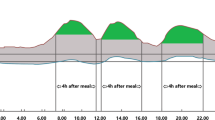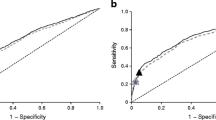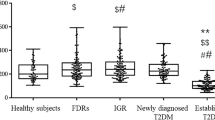Abstract
Purpose
Little is known about the underlying physiology that contributes to Haemoglobin A1c (HbA1c) in the normal and pre-diabetic range. We determined the contribution of fasting plasma glucose (FPG), 2-h plasma glucose (2hPG), insulin secretion, insulin sensitivity and endogenous glucose production to HbA1c levels in the normal and pre-diabetic range.
Methods
A total of 62 Danish men and women with normal or impaired glucose regulation were studied. HbA1c levels were measured and participants underwent an oral glucose tolerance test with measurements of FPG and 2hPG, an intravenous glucose tolerance test for determination of first-phase insulin release, and a hyperinsulinaemic euglycaemic clamp for estimation of peripheral and hepatic insulin sensitivity. Associations of HbA1c with the different measures of glucose metabolism were analysed by linear regression analysis.
Results
HbA1c levels ranged from 28 to 45 mmol/mol (4.7–6.3%) in the study population. 1 SD higher (log) FPG concentration (~1 mmol/L) was associated with 2 mmol/mol higher HbA1c concentration (P < 0.001). In comparison, 1 SD higher levels of (log) first-phase insulin secretion or (log) disposition index were associated with 1.5 mmol/mol lower HbA1c levels (P < 0.05). HbA1c was not associated with peripheral or hepatic insulin sensitivity, endogenous glucose production or 2hPG levels.
Conclusion
HbA1c levels within the normal and pre-diabetic range seem to reflect decreased insulin secretion to a higher extent than insulin resistance. Therefore, early prevention strategies for high-risk individuals identified by HbA1c are not straightforward. More research on how to improve the health of beta cells either directly or indirectly in high-risk individuals is needed.

Similar content being viewed by others
References
S. Ligthart, T.T. van Herpt, M.J. Leening, M. Kavousi, A. Hofman, B.H. Stricker, M. van Hoek, E.J. Sijbrands, O.H. Franco, A. Dehghan, Lifetime risk of developing impaired glucose metabolism and eventual progression from prediabetes to type 2 diabetes: a prospective cohort study. Lancet Diabetes Endocrinol. 4(1), 44–51 (2016)
E.S. Ford, G. Zhao, C. Li, Pre-diabetes and the risk for cardiovascular disease: a systematic review of the evidence. J. Am. Coll. Cardiol. 55(13), 1310–1317 (2010)
J.M. Mooy, P.A. Grootenhuis, H. de Vries, P.J. Kostense, C. Popp-Snijders, L.M. Bouter, R.J. Heine, Intra-individual variation of glucose, specific insulin and proinsulin concentrations measured by two oral glucose tolerance tests in a general Caucasian population: the Hoorn Study. Diabetologia 39(3), 298–305 (1996)
K. Færch, K. Borch-Johnsen, J.J. Holst, A. Vaag, Pathophysiology and aetiology of impaired fasting glycaemia and impaired glucose tolerance: does it matter for prevention and treatment of type 2 diabetes? Diabetologia 52(9), 1714–1723 (2009)
American Diabetes Association, Standards of medical care in diabetes—2010. Diabetes Care 33(Suppl 1), S11–S61 (2010)
The International Expert Committee, International Expert Committee Report on the role of the A1C assay in the diagnosis of diabetes. Diabetes Care 32(7), 1327–1334 (2009)
I.M. Stratton, A.I. Adler, H.A. Neil, D.R. Matthews, S.E. Manley, C.A. Cull, D. Hadden, R.C. Turner, R.R. Holman, Association of glycaemia with macrovascular and microvascular complications of type 2 diabetes (UKPDS 35): prospective observational study. BMJ 321, 405–412 (2000)
T. Jørgensen, K. Borch-Johnsen, T.F. Thomsen, H. Ibsen, C. Glümer, P. Charlotta, A randomized non-pharmacological intervention study for prevention of ischaemic heart disease: baseline results Inter99 (1). Eur. J. Cardiovasc. Prev. Rehab. 10(5), 377–386 (2003)
K. Færch, A. Vaag, J. Holst, C. Glümer, O. Pedersen, K. Borch-Johnsen, Impaired fasting glycaemia vs impaired glucose tolerance: similar impairment of pancreatic alpha and beta cell function but differential roles of incretin hormones and insulin action. Diabetologia 51(5), 853–861 (2008)
R.A. DeFronzo, J.D. Tobin, R. Andres, Glucose clamp tecnique: a method for quantifying insulin secretion and resistance, Am. J. Physiol. 237(3), E214–E223 (1979)
K. Færch, C. Brøns, A.C. Alibegovic, A. Vaag, The disposition index: adjustment for peripheral vs. hepatic insulin sensitivity? J. Physiol. 588(5), 759–764 (2010)
R. Steele, Influences of glucose loading and of injected insulin on hepatic glucose output. Ann. N. Y. Acad. Sci. 82, 420–430 (1959)
M.A. Abdul-Ghani, M. Matsuda, B. Balas, R.A. DeFronzo, Muscle and liver insulin resistance indexes derived from the oral glucose tolerance test. Diabetes Care 30(1), 89–94 (2007)
M.J. Christopher, C. Rantzau, G.M. Ward, F.P. Alford, Insulinopenia and hyperglycemia influence the in vivo partitioning of GE and SI. Am. J. Physiol. 268(3 Pt 1), E410–E421 (1995)
O. Hother-Nielsen, H. Beck-Nielsen, On the determination of basal glucose production rate in patients with type 2 (non-insulin-dependent) diabetes mellitus using primed-continuous 3-3H-glucose infusion. Diabetologia 33(10), 603–610 (1990)
R.A. DeFronzo, Banting lecture. From the triumvirate to the ominous octet: a new paradigm for the treatment of type 2 diabetes mellitus. Diabetes 58(4), 773–795 (2009)
E. Barry, S. Roberts, J. Oke, S. Vijayaraghavan, R. Normansell, T. Greenhalgh, Efficacy and effectiveness of screen and treat policies in prevention of type 2 diabetes: systematic review and meta-analysis of screening tests and interventions, BMJ 356, i6538 (2017)
L. Monnier, H. Lapinski, C. Colette, Contributions of fasting and postprandial plasma glucose increments to the overall diurnal hyperglycemia of type 2 diabetic patients: variations with increasing levels of HbA1c. Diabetes Care 26(3), 881–885 (2003)
M. Riddle, G. Umpierrez, A. DiGenio, R. Zhou, J. Rosenstock, Contributions of basal and postprandial hyperglycemia over a wide range of A1C levels before and after treatment intensification in type 2 diabetes. Diabetes Care 34(12), 2508–2514 (2011)
K. Færch, M. Alssema, D.J. Mela, R. Borg, D. Vistisen, Relative contributions of preprandial and postprandial glucose exposures, glycemic variability, and non-glycemic factors to HbA1c in individuals with and without diabetes. Nutr. Diabetes 8(1), 38 (2018)
C. Chen, Y.Q. Tu, P. Yang, Q.L. Yu, S. Zhang, F. Xiong, C.Y. Wang, Assessing the impact of cigarette smoking on beta-cell function and risk for type 2 diabetes in a non-diabetic Chinese cohort. Am. J. Transl. Res. 10(7), 2164–2174 (2018)
T. Li, L. Ni, Z. Zhao, X. Liu, Z. Lai, X. Di, Z. Xie, X. Song, X. Wang, R. Zhang, C. Liu, Melatonin attenuates smoking-induced hyperglycemia via preserving insulin secretion and hepatic glycogen synthesis in rats. J. Pineal Res. 64(4), e12475 (2018)
K. Færch, A. Vaag, D.R. Witte, T. Jørgensen, O. Pedersen, K. Borch-Johnsen, Predictors of future fasting and 2-hour post-OGTT plasma glucose levels in middle-aged men and women—the Inter99 study. Diabet. Med. 26(4), 377–383 (2009)
A. Borai, C. Livingstone, F. Abdelaal, A. Bawazeer, V. Keti, G. Ferns, The relationship between glycosylated haemoglobin (HbA1c) and measures of insulin resistance across a range of glucose tolerance. Scand. J. Clin. Lab. Investig. 71(2), 168–172 (2011)
Y. Heianza, Y. Arase, K. Fujihara, H. Tsuji, K. Saito, S.D. Hsieh, S. Kodama, H. Shimano, N. Yamada, S. Hara, H. Sone, High normal HbA(1c) levels were associated with impaired insulin secretion without escalating insulin resistance in Japanese individuals: the Toranomon Hospital Health Management Center Study 8 (TOPICS 8). Diabet. Med. J. Br. Diabet. Assoc. 29(10), 1285–1290 (2012)
M. Kanat, D. Winnier, L. Norton, N. Arar, C. Jenkinson, R.A. DeFronzo, M.A. Abdul-Ghani, The relationship between beta-cell function and glycated hemoglobin: results from the Veterans Administration Genetic Epidemiology Study. Diabetes Care 34(4), 1006–1010 (2011)
K. Færch, N. Borup-Johansen, D.R. Witte, T. Lauritzen, M.E. Jørgensen, D. Vistisen, Relationship between insulin resistance and beta cell dysfunction in subphenotypes of pre-diabetes and type 2 diabetes. J. Clin. Endocrinol. Metab. 100(2), 707–716 (2015)
M. Fizelova, A. Stancáková, C. Lorenzo, S.M. Haffner, H. Cederberg, J. Kuusisto, M. Laakso, Glycated hemoglobin levels are mostly dependent on nonglycemic parameters in 9398 Finnish men without diabetes. J. Clin. Endocrinol. Metab. 100(5), 1989–1996 (2015)
K. Færch, A. Hulman, T.P. Solomon, Heterogeneity of pre-diabetes and type 2 diabetes: implications for prediction, prevention and treatment responsiveness. Curr. Diab Rev. 12(1), 30–41 (2015)
W.C. Knowler, E. Barrett-Connor, S.E. Fowler, R.F. Hamman, J.M. Lachin, E.A. Walker, D.M. Nathan, P.P.R.G. Diabetes, Reduction in the incidence of type 2 diabetes with lifestyle intervention or metformin. N. Engl. J. Med 346(6), 393–403 (2002)
T. Saito, M. Watanabe, J. Nishida, T. Izumi, M. Omura, T. Takagi, R. Fukunaga, Y. Bandai, N. Tajima, Y. Nakamura, M. Ito, Lifestyle modification and prevention of type 2 diabetes in overweight Japanese with impaired fasting glucose levels: a randomized controlled trial. Arch. Intern. Med. 171(15), 1352–1360 (2011)
RISE Consortium, Impact of insulin and metformin versus metformin alone on beta-cell function in youth with impaired glucose tolerance or recently diagnosed type 2 diabetes. Diabetes Care 41(8), 1717–1725 (2018)
RISE Consortium, Lack of durable improvements in beta-cell function following withdrawal of pharmacological interventions in adults with impaired glucose tolerance or recently diagnosed type 2 diabetes. Diabetes Care 42(9), 1742–1751 (2019)
Acknowledgements
The authors thank the laboratory technicians and all the participants. The experimental study was supported by the Danish Ministry of Science, Technology and Innovation, the Danish Diabetes Association, the Novo Nordisk Foundation and the Foundation of Gerda and Aage Haensch.
Author information
Authors and Affiliations
Corresponding author
Ethics declarations
Conflict of interest
L.B. has received scholarship funding from Innovation Fund Denmark, the Novo Nordisk Foundation and the University of Copenhagen. K.F. is supported by the Novo Nordisk Foundation (NNF14OC0009875). The funders had no influence on the manuscript preparation or the decision to publish. The other authors declare no conflict of interest.
Ethical approval
The protocol was in accordance with the Helsinki declaration and approved by the local ethical committee.
Informed consent
All participants provided written informed consent before taking part in the study.
Additional information
Publisher’s note Springer Nature remains neutral with regard to jurisdictional claims in published maps and institutional affiliations.
Rights and permissions
About this article
Cite this article
Bruhn, L., Vistisen, D., Vainø, C.T.R. et al. Physiological factors contributing to HbA1c in the normal and pre-diabetic range: a cross-sectional analysis. Endocrine 68, 306–311 (2020). https://doi.org/10.1007/s12020-020-02234-3
Received:
Accepted:
Published:
Issue Date:
DOI: https://doi.org/10.1007/s12020-020-02234-3




